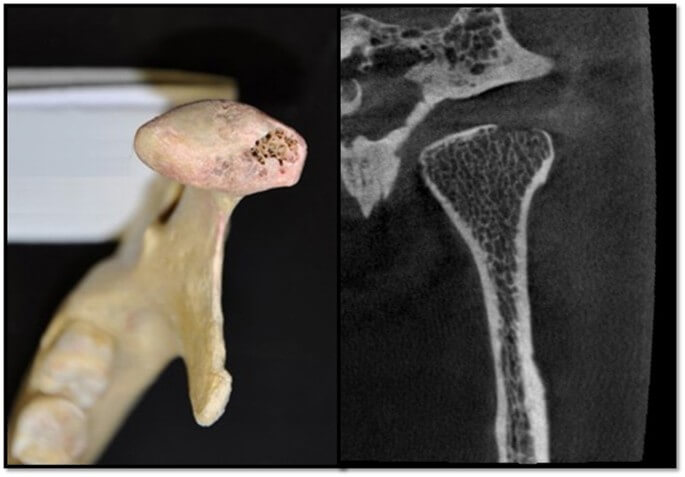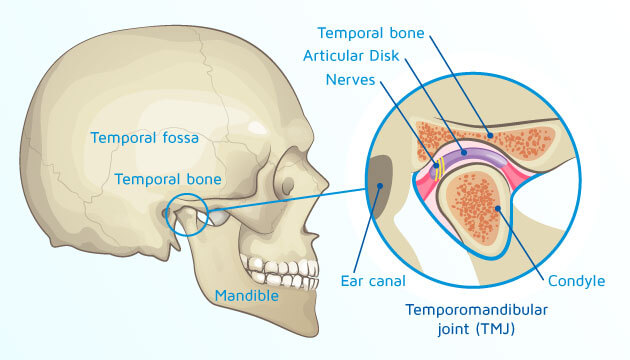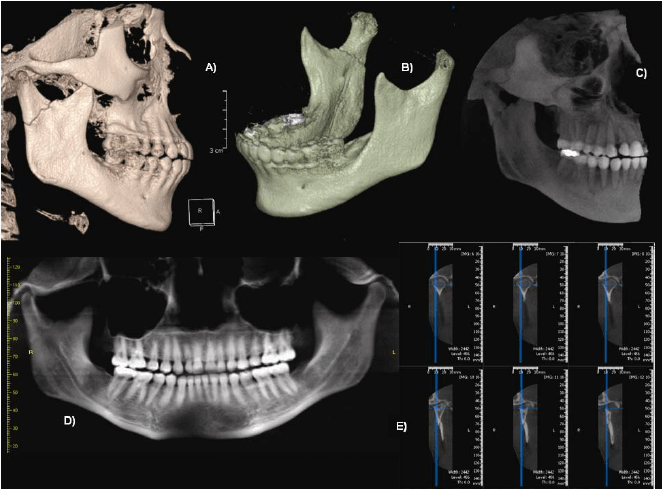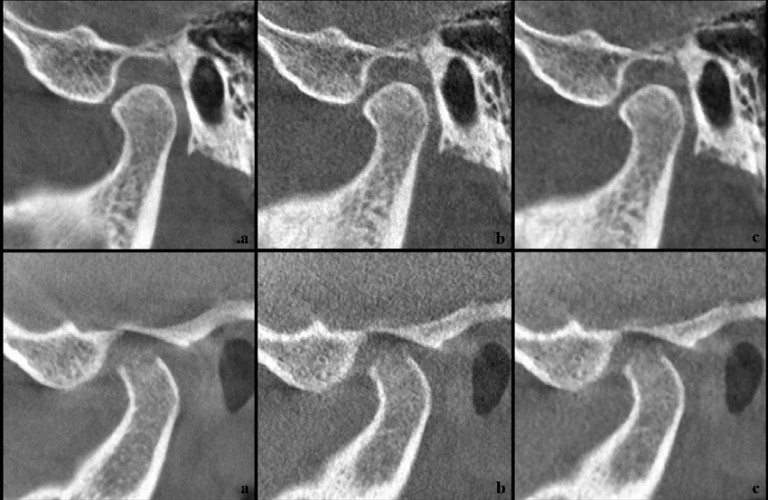CBCT Scan For TMJ

Temporomandibular joint (TMJ) disorders can be debilitating, affecting millions of individuals worldwide and manifesting in various forms of discomfort, pain, and limited jaw movement. In the pursuit of effective diagnosis and treatment, Cone Beam Computed Tomography (CBCT) scans have emerged as a powerful tool, providing detailed three-dimensional imaging of the TMJ region. This technology offers clinicians a comprehensive view of the joint’s structure, allowing for precise assessment of anatomical abnormalities, joint morphology, and pathology. In this blog post, we delve into the significance of CBCT scans in the evaluation of TMJ disorders, exploring their benefits, applications, and contribution to improved patient care.
Before you deciding on whether a CBCT Scan for TMJ is right for you, there are some things you should know:
Table of Contents
If you have any further questions about CBCT Scans at Oral Radiology Toronto, please contact us.
What Are CBCT Scans?
Cone Beam Computed Tomography (CBCT) scans represent a significant advancement in medical imaging technology, specifically designed for capturing high-resolution three-dimensional images of the craniofacial region, including the temporomandibular joint (TMJ). Unlike traditional medical CT scans, CBCT utilizes a cone-shaped X-ray beam, which rotates around the patient’s head to produce a series of cross-sectional images. These images are then reconstructed by specialized software to generate detailed 3D representations of the scanned area with remarkable accuracy. CBCT scans offer superior spatial resolution and lower radiation exposure compared to conventional CT scans, making them an ideal choice for imaging TMJ disorders and associated structures. This technology enables clinicians to visualize intricate anatomical details of the TMJ complex, facilitating precise diagnosis and treatment planning for patients suffering from TMJ-related issues.
What Is TMJ Disorder?
TMJ disorders, short for temporomandibular joint disorders, encompass a range of conditions that affect the temporomandibular joint, as well as the surrounding muscles and tissues responsible for jaw movement and function. The temporomandibular joint serves as a pivotal hinge connecting the jawbone to the skull, facilitating essential movements such as chewing, speaking, and yawning. TMJ disorders can manifest in various symptoms, including jaw pain, clicking or popping sounds during jaw movement, difficulty chewing or opening the mouth fully, and even facial pain or headaches.
These disorders can stem from a variety of causes, including trauma or injury to the jaw, arthritis, teeth grinding (bruxism), misalignment of the teeth or jaw, stress, or muscle tension. The complexity of TMJ disorders often requires a multidisciplinary approach for accurate diagnosis and effective management, involving dentists, oral and maxillofacial surgeons, orthodontists, and sometimes physical therapists or pain specialists.
Left untreated, TMJ disorders can significantly impact an individual’s quality of life, leading to chronic pain, discomfort, and limitations in daily activities. Therefore, timely diagnosis and appropriate treatment interventions are crucial for alleviating symptoms and restoring normal jaw function. Advanced imaging techniques, such as Cone Beam Computed Tomography (CBCT) scans, play a vital role in the diagnosis and management of TMJ disorders by providing detailed visualization of the joint anatomy and any underlying abnormalities.

What Are Different Types Of TMJ Disorders?
Temporomandibular joint (TMJ) disorders encompass a spectrum of conditions that can affect the function and comfort of the jaw joint and surrounding structures. These disorders can be broadly categorized into several types, each characterized by distinct symptoms, causes, and treatment approaches. Understanding the different types of TMJ disorders is crucial for accurate diagnosis and tailored management strategies. Here are some of the most common types:
- Myofascial Pain Syndrome: Myofascial pain syndrome involves discomfort or pain in the muscles that control jaw movement. It is often associated with muscle tension, trigger points, and localized tenderness. Myofascial pain can result from habits like teeth grinding (bruxism), clenching the jaw, or stress-induced muscle tension.
- Internal Derangement: Internal derangement refers to structural abnormalities within the TMJ, such as displacement of the articular disc, joint dislocation, or abnormal condylar position. This type of disorder can lead to clicking, popping, or locking of the jaw joint, as well as limited jaw movement and pain during jaw function.
- Arthritic Conditions: Arthritis affecting the TMJ can cause inflammation, degradation of joint cartilage, and bony changes within the joint. Common types of arthritis that can affect the TMJ include osteoarthritis, rheumatoid arthritis, and psoriatic arthritis. Arthritic TMJ disorders often result in chronic joint pain, stiffness, and progressive deterioration of joint function.
- Degenerative Joint Disease: Degenerative joint disease, also known as osteoarthritis of the TMJ, involves the gradual breakdown of joint cartilage and bone within the TMJ complex. This condition typically occurs due to wear and tear over time, leading to pain, stiffness, and reduced mobility of the jaw joint.
- Traumatic Injuries: Trauma to the jaw, such as fractures or dislocations, can result in acute or chronic TMJ disorders. Injuries to the TMJ may lead to pain, swelling, difficulty chewing, and abnormalities in jaw movement. Proper diagnosis and management of traumatic TMJ injuries are essential for minimizing long-term complications.
- Congenital or Developmental Anomalies: Some individuals may have congenital or developmental anomalies affecting the TMJ, such as abnormal joint morphology, jaw asymmetry, or malocclusion (misalignment of the teeth). These anatomical variations can predispose individuals to TMJ disorders and may require specialized treatment approaches.
Recognizing the specific type of TMJ disorder is crucial for implementing appropriate treatment strategies, which may include conservative measures such as pain management, physical therapy, occlusal splints, or surgical interventions in severe cases. A comprehensive evaluation by a healthcare professional, often involving clinical examination and diagnostic imaging such as Cone Beam Computed Tomography (CBCT) scans, is essential for accurate diagnosis and personalized treatment planning tailored to each individual’s needs.

Why Do I Need A CBCT Scan For TMJ?
Cone Beam Computed Tomography (CBCT) scans have become an indispensable tool in the assessment and management of temporomandibular joint (TMJ) disorders due to their ability to provide detailed three-dimensional imaging of the TMJ complex. Unlike conventional imaging techniques like traditional X-rays, CBCT scans offer superior resolution and clarity, allowing clinicians to visualize the intricate structures of the TMJ region with remarkable precision.
One of the primary reasons for utilizing CBCT scans in TMJ evaluation is their capability to capture images in multiple planes, providing comprehensive views of the joint from various angles. This multidimensional approach enables clinicians to assess not only the bony structures of the TMJ but also the soft tissues, ligaments, and surrounding anatomy. By obtaining detailed images of the TMJ, CBCT scans facilitate accurate diagnosis of TMJ disorders, including identifying abnormalities such as joint degeneration, osteoarthritis, disc displacement, or structural anomalies.
Furthermore, CBCT scans allow for precise measurement and analysis of important TMJ parameters, such as condylar position, joint space, and morphology. This information is invaluable in treatment planning, as it helps clinicians tailor interventions to each patient’s specific anatomical characteristics and pathology. Additionally, CBCT scans enable clinicians to evaluate the relationship between the TMJ and neighboring structures, such as the teeth, sinuses, and airway, which may contribute to or exacerbate TMJ symptoms.
Moreover, CBCT scans offer the advantage of lower radiation exposure compared to conventional CT scans, making them a safer option for patients undergoing imaging for TMJ evaluation. The enhanced diagnostic capabilities of CBCT scans empower clinicians to make informed decisions regarding treatment modalities, whether conservative therapies, such as physical therapy and medications, or more invasive interventions, such as arthroscopy or joint surgery.
In summary, the utilization of CBCT scans in TMJ assessment provides clinicians with comprehensive and detailed information essential for accurate diagnosis, treatment planning, and improved patient outcomes. By offering high-resolution imaging of the TMJ complex, CBCT scans contribute significantly to the advancement of TMJ care, ensuring tailored and effective management of TMJ disorders.

How Much Does A CBCT Scan Cost For TMJ?
At Oral Radiology Toronto, we provide quick and convenient dental CBCT scans for busy dentists and patients in the Toronto area. Our CBCT scans are useful for assessing the teeth, their supporting structures, the mandible and maxilla up to the floor of the nose.
Our competitively priced dental CBCT scans are professionally reviewed and interpreted by a Canadian licensed Oral Radiologist.
Prices are based on the size of CBCT volume:
- Small Field CBCT (most dental cases; 5x5cm): $234
- Medium Field CBCT : $315.90
- Large Field CBCT (8x8cm): $399
- Panoramic X-Ray: $84
Normal CBCT report turnaround time is up to 10 business days. Expedited reporting (2 business days) is an extra $50.
Please note that we do NOT offer field of views larger than 8x8cm or imaging of structures outside the maxilla and mandible, such as the temporomandibular joints, paranasal sinuses, the cervical spine, the neck and the airway spaces (i.e. craniofacial CT scan).
How Do I Get A CBCT Scan For TMJ?
- For Referring Dentists: Refer a dental patient for a CBCT Scan using our Online Referral Form.
- For Dental Patients: Schedule a CBCT scan visit at Oral Radiology Toronto using our Online Appointment Booking System.
